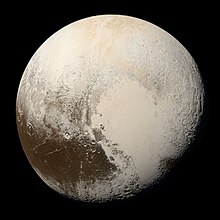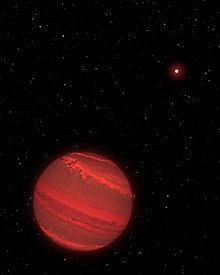行星质量天体

行星质量体 (英语:planetary-mass object或planemo,PMO)[2]或行星体(英语:planetary body),根据天体地球物理定义,任何天体的质量足以实现流体静力平衡,但不足以像恒星一样维持核心的核聚变反应[3][4]。
这个术语的目的是将比“行星”更广泛的天体分类在一起,因为许多在地球物理术语上相似的天体不符合对行星的传统期望。行星质量的天体在起源和位置上可能非常多样化。它们包括行星、矮行星、行星质量卫星和自由漂浮的行星,它们可能是从系统中喷出的(流浪行星),或是通过云坍塌而不是吸积(次棕矮星)形成的。
天文学中的用法
[编辑]虽然这个术语在科技上包括系外行星和其它物体,但它通常用于性质不确定的物体或不属于某一特定类别的物体。该术语经常使用的情况:
- 孤立的行星质量体(iPMO;IPMO)是自由漂浮的天体,其质量低于氘融合,其性质是喷出的自由漂浮行星或次棕矮星,但尚未完全解决(例如2MASS J13243553+6358281[5]、在NGC 1333的PSO J060.3200+25.9644[6][7]。)
- 质量范围在氘融合边界的天体(VHS 1256-1257 b[8]、BD+60 1417b[9]。)
- 围绕恒星或棕矮星运行的天体,但其作为系外行星的形成具有挑战性或不可能(VHS 1256-1257 b、CFHTWIR-Oph 98B[10]。)
类型
[编辑]行星质量卫星
[编辑]
三颗最大的卫星盖尼米德、泰坦和卡利斯多的大小与水星相似或更大;这些和另外四颗:埃欧、月球、欧罗巴和特里顿,比体积最大、质量最高的矮行星阋神星和冥王星更大、质量也更高。另外十几颗较小的卫星也足够大,在它们历史上的某个时刻,通过自身的引力、来自母行星的潮汐加热,或者两者兼而有之,已经变成了圆形。特别是,与地球一样,泰坦表面有厚厚的大气层和稳定的液体(尽管对泰坦来说,液体是甲烷而不是水)。行星地球物理定义的支持者认为,位置不重要,在行星的定义中只应考虑地球物理内容。“卫星行星”一词有时用于行星大小的卫星[11]。
矮行星
[编辑]
矮行星是一种行星质量体,既不是真正的行星,也不是天然卫星;它的轨道直接绕行恒星,质量足以使其引力将其压缩成流体静力平衡的形状(通常是球体),但尚未清除其轨道周围的其它物质。行星科学家和“新视野号”首席研究员阿兰·斯特恩(英语:Alan Stern)提出了“矮行星”一词,他认为位置不重要,只应考虑地球物理内容,因此矮行星是行星的一种子型。国际天文学联合会(IAU)接受了这个术语(而不是更中性的“小行星”),但决定将矮行星归类为一项单独的天体类别[12]。
行星和系外行星
[编辑]行星(英语:planet;拉丁语:planeta),通常指自身不发光,环绕着恒星的天体。其公转方向常与所绕恒星的自转方向相同[13](由西向东)。一般来说行星需具有一定质量,行星的质量要足够大(相对于月球)且近似于圆球状,自身不能像恒星那样发生核聚变反应。2007年5月,麻省理工学院一组太空科学研究队发现了目前已知最热的行星(2040摄氏度)[14]。随着一些具有太阳大小的天体被发现,“行星”一词的科学定义似乎更形迫切。历史上行星名字来自于它们的位置(与恒星的相对位置)在天空中不固定,就好像它们在星空中行走一般。太阳系内肉眼可见的5颗行星水星、金星、火星、木星和土星早在史前就已经被人类发现了。16世纪之后日心说取代了地心说,使人类了解到地球本身也是一颗行星。望远镜被发明和万有引力被发现后,人类又发现了天王星、海王星,冥王星(2006年后被排除出行星行列,2008年被重分类为类冥天体,属于矮行星的一种)还有为数不少的小行星。20世纪末的人类在太阳系外的恒星系统中也发现了行星。
前恒星
[编辑]在近距离的联星系统中,其中一颗恒星可能会因较重的伴星而失去质量。吸积驱动的脉冲星可能会导致质量损失。收缩的恒星,然后可以变成一个行星质量体。一个例子是围绕脉冲星PSR J1719−1438运行的木星质量物体[15]。这些缩小的白矮星可能会成为氦行星或碳行星。
次棕矮星
[编辑]
恒星是通过气体云的引力坍缩形成的,但较小的物体也可以通过云坍缩形成。以这种管道形成的行星质量体有时被称为次棕矮星。次棕矮星可能是自由漂浮的,例如Cha 110913−773444[17]和OTS 44[18],或绕较大物体运行,例如 2MASS J04414489+2301513。.
次棕矮星的联星系统在理论上是可能的;Oph 162225-240515最初被认为是一颗14木星质量的棕矮星和7木星质量的次棕矮星的联星系统,但进一步的观测将后者的估计质量向上修正为大于13木星质量,根据IAU的工作定义,使其成为棕矮星[19][20][21]。
捕获的行星
[编辑]星团中的星际行星与恒星的速度相似,因此可以重新捕获。它们通常被捕获到100到105 AU。捕获效率随着星团体积的增加而降低,和对于给定的星团大小,捕获效率随着主星/主质量的增加而增加。单颗和多颗行星可能被捕获到任意的不对齐轨道上,彼此不共面,或与宿主恒星旋转或预先存在的行星系统不共面[22]。
星际行星
[编辑]几次恒星和行星系统形成的电脑模拟表明,一些行星质量的物体会被喷发到星际空间中[23]。这种天体通常被称为“星际行星”。
相关条目
[编辑]- 行星质量
- 太阳系流体静力平衡天体列表
- 太阳系天体大小列表
参考资料
[编辑]- ^ Brown, Michael E.; Butler, Bryan. Masses and densities of dwarf planet satellites measured with ALMA. The Planetary Science Journal. July 2023, 4 (10): 11. Bibcode:2023PSJ.....4..193B. arXiv:2307.04848
 . doi:10.3847/PSJ/ace52a
. doi:10.3847/PSJ/ace52a  .
.
- ^ Weintraub, David A. Is Pluto a Planet?: A Historical Journey through the Solar System. Princeton University Press. 2014: 226. ISBN 978-1400852970.
- ^ Basri, Gibor; Brown, E. M. Planetesimals to Brown Dwarfs: What is a Planet?. Annual Review of Earth and Planetary Sciences. May 2006, 34: 193–216. Bibcode:2006AREPS..34..193B. S2CID 119338327. arXiv:astro-ph/0608417
 . doi:10.1146/annurev.earth.34.031405.125058.
. doi:10.1146/annurev.earth.34.031405.125058.
- ^ Stern, S. Alan; Levison, Harold F. Rickman, H. , 编. Regarding the criteria for planethood and proposed planetary classification schemes. Highlights of Astronomy (San Francisco, CA: Astronomical Society of the Pacific). 2002, 12: 208. Bibcode:2002HiA....12..205S. ISBN 978-1-58381-086-6. doi:10.1017/S1539299600013289
 .
.
- ^ Gagné, Jonathan; Allers, Katelyn N.; Theissen, Christopher A.; Faherty, Jacqueline K.; Bardalez Gagliuffi, Daniella; Artigau, Étienne. 2MASS J13243553+6358281 Is an Early T-type Planetary-mass Object in the AB Doradus Moving Group. The Astrophysical Journal. 2018-02-01, 854 (2): L27. Bibcode:2018ApJ...854L..27G. ISSN 0004-637X. arXiv:1802.00493
 . doi:10.3847/2041-8213/aaacfd
. doi:10.3847/2041-8213/aaacfd  .
.
- ^ Best, William M. J.; Liu, Michael C.; Magnier, Eugene A.; Bowler, Brendan P.; Aller, Kimberly M.; Zhang, Zhoujian; Kotson, Michael C.; Burgett, W. S.; Chambers, K. C.; Draper, P. W.; Flewelling, H.; Hodapp, K. W.; Kaiser, N.; Metcalfe, N.; Wainscoat, R. J. A Search for L/T Transition Dwarfs with Pan-STARRS1 and WISE. III. Young L Dwarf Discoveries and Proper Motion Catalogs in Taurus and Scorpius-Centaurus. The Astrophysical Journal. 2017-03-01, 837 (1): 95. Bibcode:2017ApJ...837...95B. ISSN 0004-637X. arXiv:1702.00789
 . doi:10.3847/1538-4357/aa5df0
. doi:10.3847/1538-4357/aa5df0  .
.
- ^ Scholz, Aleks; Muzic, Koraljka; Jayawardhana, Ray; Almendros-Abad, Victor; Wilson, Isaac. Disks around Young Planetary-mass Objects: Ultradeep Spitzer Imaging of NGC 1333. The Astronomical Journal. 2023-05-01, 165 (5): 196. Bibcode:2023AJ....165..196S. ISSN 0004-6256. arXiv:2303.12451
 . doi:10.3847/1538-3881/acc65d
. doi:10.3847/1538-3881/acc65d  .
.
- ^ Miles, Brittany E.; Biller, Beth A.; Patapis, Polychronis; Worthen, Kadin; Rickman, Emily; Hoch, Kielan K. W.; Skemer, Andrew; Perrin, Marshall D.; Whiteford, Niall; Chen, Christine H.; Sargent, B.; Mukherjee, Sagnick; Morley, Caroline V.; Moran, Sarah E.; Bonnefoy, Mickael. The JWST Early-release Science Program for Direct Observations of Exoplanetary Systems II: A 1 to 20 μm Spectrum of the Planetary-mass Companion VHS 1256-1257 b. The Astrophysical Journal. 2023-03-01, 946 (1): L6. Bibcode:2023ApJ...946L...6M. ISSN 0004-637X. arXiv:2209.00620
 . doi:10.3847/2041-8213/acb04a
. doi:10.3847/2041-8213/acb04a  .
.
- ^ Faherty, Jacqueline K.; Gagné, Jonathan; Popinchalk, Mark; Vos, Johanna M.; Burgasser, Adam J.; Schümann, Jörg; Schneider, Adam C.; Kirkpatrick, J. Davy; Meisner, Aaron M.; Kuchner, Marc J.; Bardalez Gagliuffi, Daniella C.; Marocco, Federico; Caselden, Dan; Gonzales, Eileen C.; Rothermich, Austin. A Wide Planetary Mass Companion Discovered through the Citizen Science Project Backyard Worlds: Planet 9. The Astrophysical Journal. 2021-12-01, 923 (1): 48. Bibcode:2021ApJ...923...48F. ISSN 0004-637X. arXiv:2112.04678
 . doi:10.3847/1538-4357/ac2499
. doi:10.3847/1538-4357/ac2499  .
.
- ^ Fontanive, Clémence; Allers, Katelyn N.; Pantoja, Blake; Biller, Beth; Dubber, Sophie; Zhang, Zhoujian; Dupuy, Trent; Liu, Michael C.; Albert, Loïc. A Wide Planetary-mass Companion to a Young Low-mass Brown Dwarf in Ophiuchus. The Astrophysical Journal. 2020-12-01, 905 (2): L14. Bibcode:2020ApJ...905L..14F. ISSN 0004-637X. arXiv:2011.08871
 . doi:10.3847/2041-8213/abcaf8
. doi:10.3847/2041-8213/abcaf8  .
.
- ^ Villard, Ray. Should Large Moons Be Called 'Satellite Planets'?. Discovery News. 2010-05-14 [2011-11-04]. (原始内容存档于2010-05-16).
- ^ Resolution B5 Definition of a Planet in the Solar System (PDF). IAU 2006 General Assembly. International Astronomical Union. [January 26, 2008].
- ^ BBC NEWS | Science & Environment | New exoplanet orbits 'backwards'. [2009-08-18]. (原始内容存档于2010-06-24).
- ^ Team discovers hottest planet - MIT News Office. [2007-05-18]. (原始内容存档于2013-12-25).
- ^ Bailes, M.; Bates, S. D.; Bhalerao, V.; Bhat, N. D. R.; et al. Transformation of a Star into a Planet in a Millisecond Pulsar Binary. Science. 2011, 333 (6050): 1717–20. Bibcode:2011Sci...333.1717B. PMID 21868629. S2CID 206535504. arXiv:1108.5201
 . doi:10.1126/science.1208890.
. doi:10.1126/science.1208890.
- ^ Artist's View of a Super-Jupiter around a Brown Dwarf (2M1207). ESA/Hubble. 19 February 2016 [22 February 2016]. (原始内容存档于Apr 17, 2021).
- ^ Luhman, K. L.; Adame, Lucía; D'Alessio, Paola; Calvet, Nuria. Discovery of a Planetary-Mass Brown Dwarf with a Circumstellar Disk. Astrophysical Journal. 2005, 635 (1): L93. Bibcode:2005ApJ...635L..93L. S2CID 11685964. arXiv:astro-ph/0511807
 . doi:10.1086/498868.
. doi:10.1086/498868.
- Whitney Clavin. A Planet With Planets? Spitzer Finds Cosmic Oddball. NASA (新闻稿). 2005-11-29 [2022-07-29]. (原始内容存档于2012-10-11).
- ^ Joergens, V.; Bonnefoy, M.; Liu, Y.; Bayo, A.; et al. OTS 44: Disk and accretion at the planetary border. Astronomy & Astrophysics. 2013, 558 (7): L7. Bibcode:2013A&A...558L...7J. S2CID 118456052. arXiv:1310.1936
 . doi:10.1051/0004-6361/201322432.
. doi:10.1051/0004-6361/201322432.
- ^ Close, Laird M.; Zuckerman, B.; Song, Inseok; Barman, Travis; et al. The Wide Brown Dwarf Binary Oph 1622–2405 and Discovery of A Wide, Low Mass Binary in Ophiuchus (Oph 1623–2402): A New Class of Young Evaporating Wide Binaries?. Astrophysical Journal. 2007, 660 (2): 1492–1506. Bibcode:2007ApJ...660.1492C. S2CID 15170262. arXiv:astro-ph/0608574
 . doi:10.1086/513417.
. doi:10.1086/513417.
- ^ Luhman, Kevin L.; Allers, Katelyn N.; Jaffe, Daniel T.; Cushing, Michael C.; Williams, Kurtis A.; Slesnick, Catherine L.; Vacca, William D. Ophiuchus 1622-2405: Not a Planetary-Mass Binary. The Astrophysical Journal. April 2007, 659 (2): 1629–1636. Bibcode:2007ApJ...659.1629L. S2CID 11153196. arXiv:astro-ph/0701242
 . doi:10.1086/512539.
. doi:10.1086/512539.
- ^ Britt, Robert Roy. Likely First Photo of Planet Beyond the Solar System. Space. 2004-09-10 [2008-08-23]. (原始内容存档于Jan 27, 2011).
- ^ On the origin of planets at very wide orbits from the re-capture of free floating planets 互联网档案馆的存档,存档日期2022-04-12., Hagai B. Perets, M. B. N. Kouwenhoven, 2012
- ^ Lissauer, J. J. Timescales for Planetary Accretion and the Structure of the Protoplanetary disk. Icarus. 1987, 69 (2): 249–265. Bibcode:1987Icar...69..249L. doi:10.1016/0019-1035(87)90104-7. hdl:2060/19870013947
 .
.
Text is available under the CC BY-SA 4.0 license; additional terms may apply.
Images, videos and audio are available under their respective licenses.
